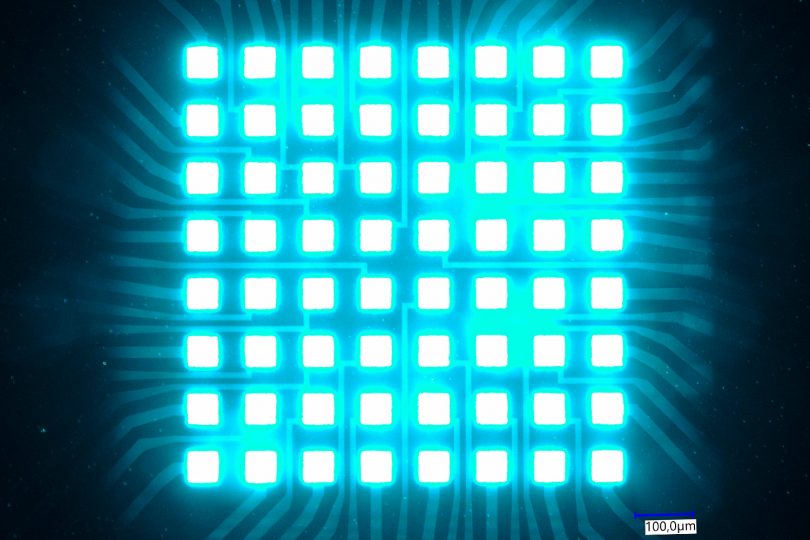Braunschweig’s microelectronics on the rise TU Braunschweig involved in four microchip design research projects
Processors, sensors, pacemakers: microelectronics are not only all around us, in some cases they are even within us. However, with the option of putting billions of transistors and other elements on a tiny chip, designing microelectronics is like building Lego land on a fingernail. At the TU Braunschweig, the scientists of the Institute for CMOS Design are exploring the manifold possibilities of microelectronics. With no less than four new successful project ideas, the institute under Professor Vadim Issakov is currently making a name for itself as one of the top locations for the subject in Germany.
The four new projects that started at the Institute for CMOS Design are as diverse as microelectronics. Together with 24 partners from research and industry, they range from radar to radio technology to biomedicine. At the same time, the new research impulses are intended to enrich the institute’s other projects. Even if each chip has its specific function: Every advance in the underlying chip design has the potential to trigger a chain reaction of innovation.
All around radar
Two of the four projects focus on radar applications. In “TIEMPO”, researchers from three universities are working together as part of the priority programme “INTEREST” of the German Research Foundation (DFG). They are combining the respective strengths of digital and analogue systems to obtain a high-resolution three-dimensional radar image in real-time. Such a super radar would push the previous limits of what is possible by a lot.
The second radar project, “VERANO“, is funded by the Federal Ministry of Education and Research (BMBF). Eleven well-known partners such as Bosch, Infineon and Mercedes are working together with scientists from the TU Braunschweig to equip vehicles with all-round radar. The goal is an entire network of sensor nodes that process their measurement data independently. With this project, the partners are taking the next step for environment recognition in traffic: unlike cameras, the radar system is independent of poor visibility or reflective surfaces.
Minimal power consumption
The BMBF project “HoLoDEC” is all about compact analogue circuits that consume as little energy as possible. Together, the 13 project partners are developing methods that can benefit a wide range of sensors. If, for example, it is possible to reduce power consumption by half, the time in which biomedical chips measure values such as pH or the like in and on the body is doubled. “These are potentially advances that will even help us in our research in Quantum Valley Lower Saxony,” explains Professor Vadim Issakov. “Nobody wants to defrost, for example, laboriously cooled qubits with power-hungry and thus heat-generating control electronics. Every milliwatt counts.”
Getting out of the cell
The six partners in the BMBF project “MassIMO” want to demonstrate an alternative mobile phone network. So far, the network has been cellular. A cell is the area covered by a transmission mast. Therefore, when a particularly large number of people need data in the same place, the respective cell mast reaches its load limit. With the cell-free concept of “MassIMO”, on the other hand, the end device has a choice of many 6G contact points in a small area. Depending on the data consumption, one connects to one or more of these points. The project partners want to put this network architecture into practice for the first time in the Braunschweig learning factory. In addition to the Institute for CMOS Design, the Institute of Machine Tools and Production Technology and, with Professor Eduard Jorswieck’s working group, the Institute for Communications Technology of the TU Braunschweig are also involved.
About the projects
TIEMPO – Terahertz Digital Chess-Board-Modulated Spread-Spectrum System for Radar and Communication Comprising 200 GHz Bandwidth
- Project partners: TU Braunschweig, TU Dresden, University of Erlangen–Nuremberg
- Funding volume: 1 million euros
- Of which to TU Braunschweig: approx. 350,000 euros
- Duration: Until February 2025
VERANO – Digital and Energy Efficient Radar Networks for Heterogeneous E/E Vehicle Architectures
- Project partners: Infineon Technologies AG, Mercedes-Benz AG, Robert Bosch GmbH, Missing Link Electronics GmbH, Fraunhofer IPMS, Karlsruhe Institute of Technology, University of Ulm, Ruhr University Bochum, TU Braunschweig, University of Kassel.
- Funding volume: 11.1 million euros
- Of which to TU Braunschweig: approx. 500,000 euros
- Duration: Until November 2025
HoLoDEC – Automated Design Methods for Highly Efficient Integrated Sensor Modules in Edge Computing Applications
- Project partners: Bosch Sensortec GmbH, Infineon Technologies AG, IMST GmbH, MunEDA GmbH, BALLUFF GmbH, Fraunhofer IIS, IMMS GmbH, Reutlingen University, TU Braunschweig, Technical University of Munich.
- Funding volume: 9.6 million euros
- Of which to TU Braunschweig: approx. 500,000 euros
- Duration: Until September 2025
MassIMO – Cell Free Massive MIMO Systems
- Project partners: Infineon Technologies AG, Erisson Antenna Technology Germany GmbH, TU Braunschweig, Fraunhofer HHI, eesy-ic GmbH.
- Funding volume: 8.7 million euros
- Of which to TU Braunschweig: approx. 1 million euros
- Duration: Until June 2025

